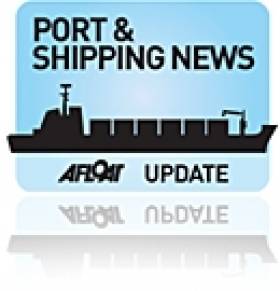Displaying items by tag: Arklow Harbour
Dredger Departs Arklow Harbour As Wicklow Port Handles Trade
#WickowPorts - UKD Orca (2000/3,087grt) yesterday departed Arklow Bay having completed capping a spoil pit site off the County Wicklow harbour which was dredged last year, writes Jehan Ashmore.
As previously reported on Afloat.ie, UKD Orca was tasked in capping a designated spoil site north-east of Arklow port's East Pier. This had involved dredging contaminated spoil material from within the harbour channel and basin by the Jenny T early last summer.
The works at Arklow port are to improve access for all users and encourage notably commercial callers to the port where the River Avoca flows through into the Irish Sea.
UKD Orca is a trailing suction dredger which was returning to Merseyside. When underway some eight nautical miles due east off Wicklow Head, was nearby at anchorage the Ceg Cosmos (1983/1,139grt). The general cargoship loaded with logged timber had sailed from Corpach, under the shadow of Ben Nevis, Scotland.
The majority of the felled tree logs where stowed in the hold though bundles of logs could be seen on the ships hatch cover.
Such trade in timber products was very much a frequent import to Wicklow Port during the heady days of the construction boom, and there appears to be somewhat a comeback to supplying such product.
This trade over the years has also seen ships from Scandinavia discharge timber packaged products through the local agency of Conway Shipping.
Last night, Ceg Cosmos which had weighed anchor only less than half a nautical mile off Black Castle, a ruin which stands on the promontory close to East Pier of the port of Wicklow. On entering the port, the 64m long vessel nudged past the short-sea general cargoship, Leine (2005/2,164grt). The 89m long vessel was been loaded with an export cargo of recycled metal while alongside North Quay.
Leine, flagged in Antigua Barbuda had docked having sailed from Cork. As for the Gibraltar flagged Ceg Cosmos she was berthed further upriver at Packet Quay.
Directly facing on the opposite South Quay on this narrower stretch within the port where the River Leitrim flows out to sea, is where a miscellaneous local inshore fishing fleet where moored abreast.
Nestled within these fishing boats was Island Shipping's wind-farm crew transfer and support catamaran Island Panther. The Southampton registered high-speed 17m craft is part of the Wicklow based company.
#ArklowHarbour - Arklow Harbour is set to have the final stage of dredging related works to be completed within the next fortnight, following last year's dredging as previously reported on Afloat.ie, writes Jehan Ashmore.
Work is to involve the capping of a pit spoil site offshore by UKD Orca, a trailing suction hopper dredger which arrived this afternoon from Liverpool's (Bootle) docks.
Afloat.ie has made inquiries to confirm that the work does not involve further dredging but is to cap contaminated spoil dredged from within the harbour early last summer.
It is understood the project then saw approximately 60,000 tonnes of spoil dredged from the port's channel, turning basin, and dock basin from where Asgard II, the brigantine was launched from the Tyrrell's yard in 1981.
A license to carry out the dredging last year was the first time such duties were performed in 15 years at the Co. Wicklow harbour. The works were carried out by Clare-based L&M Keating Ltd.
The contract costing €2.2m followed Wicklow County Council been granted a Foreshore Licence from the Department of the Environment, Community and Local Government.
As part of the conditions of the dredging contract, a permit from the Environmental Protection Agency (EPA) was issued to dump disposed spoil from the harbour at this designated pit out at sea.
On that occasion, the Sligo-registered Jenny T was tasked in dredging the spoil material to the pit site 1.5km north-east of the harbour's east pier.
The current operation by UKD Orca is expected to take 8-12 days and the 2000 built vessel is the most modern from a fleet of five vessels operated by UK Dredging, with a head office based in Cardiff.
The Dutch built 3,087 tonnes vessel is capable of dredging in confined spaces and is also designed for maintenance dredging.
Contract Signed For Dredging Of Arklow Port
#ArklowHarbour - Arklow Harbour is set to be dredged for the first time in 15 years this June after a €2.2 million contract for the job with Clare-based L&M Keating Ltd was officially signed earlier this month.
Wicklow News reports that the works were finally approved after a permit from the Environmental Protection Agency (EPA) for dumping an expected 60,000 tonnes of dredged soil from the harbour out at sea.
Arklow mayor Tommy Annesley said the dredging plans, which follow similar works in Wicklow Harbour, showed a “great commitment to the future of Arklow Port”.
Wicklow News has more on the story HERE.
Arklow Harbour Fees Had No Legal Standing Says Report
Arklow Harbour was collecting fees without ministerial approval for two decades, a new report has emerged.
According to The Irish Times, the due dilligence report shows Arklow Harbour Commissioners did not apply to the Minister for Transport for harbour rate orders - which are stipulated under the Harbours Act 1946 - between 1987 to 2007.
The report said that instead, the harbour authority "mistakenly believed they could revise the charges themselves". Because of this all increases imposed on all harbour users during the 20-year period had no legal standing.
New rates have been introduced with ministerial approval since 2009.
Paddy Mordaunt, the chairman of Arklow Harbour Commissioners, told The Irish Times he could not comment on the report for legal reasons.
The due dilligence report was produced as part of the process to switch administration of the harbour to Wicklow County Council.
The Irish Times has more on the story HERE.

































































